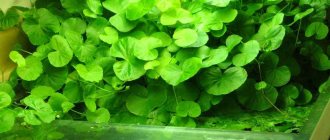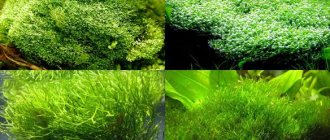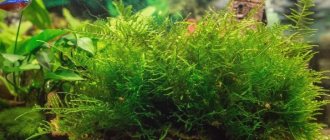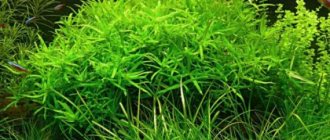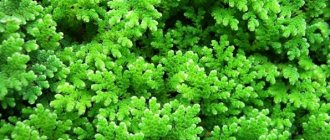Hydrocotyla tripartite
Hydrocotyla tripartita is a popular aquarium plant widely used in aquarium design. This popularity is due to the fact that with the help of this plant you can form a green mat, hills and even imitate leaves on the crowns of trees.
Hydrocotyle tripartita is often called a ground cover plant. However, this is not entirely true, since it covers the ground in a very specific way.
This plant does not take root in the ground because it has a weak root system. Tripartita can be called “hovering in the water column” - this is its peculiarity, this is its value for aquascaping.
Hydrocotyle tripartita does not need soil at all; its shoots intertwine within the group, thereby compacting it. Only those shoots that are close to the ground take root. A dense, green mat, like Hemianthus cube or Sitnyag, does not form hydrocotyl tripartite. This plant is more suited to the middle ground, which tends to create focal points, and hydrocotyla is a wonderful choice for just this purpose.
Description: The size of the hydrocotyla tripartite leaf is 1-1.5 cm. It has a slightly dissected peculiar shape. The leaves are arranged horizontally on a long stalk, two per whorl. The stem is in the form of a shoot, which intensively spreads throughout the aquarium. The distance between the whorls on the shoot can be very large - more than 5 cm. Therefore, do not be surprised if, after planting a plant in one corner of the aquarium, after some time you find its shoot in the opposite corner of the aquarium. Growth rate is average.
Without knowing the growth properties of Hydrocotyla tripartita, planting it in an aquarium can cause difficulties:
— The plant has a very weak root system and actually does not take root. Planting it in the ground makes no sense.
— The shoots of the plant do not spread along the ground, but in the water column. Therefore, when planting a bunch of hydrocotyl, it is best to simply press it to the ground with a pebble or driftwood. And from this bunch a beautiful green group will later grow.
Hydrocotyla tripartita is an easy to maintain aquarium plant. The difficulty of its maintenance lies only in achieving the best growth of even leaves. If the plant does not have enough nutrition (CO2 - 6-12 mg/l and micro and macro fertilizers ), its leaves curl down and do not have such a spectacular appearance.
Recommended lighting level from 0.5 watt/l (40lm/l).
Water parameters: temperature 20-27°C, hardness dH 6-8°, acidity pH 6.2-7.4. A weekly change of 1/4 of the aquarium water is required.
NOTE: Here is what a domestic manufacturer of meristem aquarium plants writes about Hydrocotyl tipartitis:
This is one of the smallest species of Hydrocotylus. Characterized by an interesting leaf shape and rapid growth. Under good conditions, it will instantly cover most of the aquarium with its nets. It can be used both in the foreground and in the middle and even in the background... It even grows on snags and in moss. The plant is unpretentious in lighting and unpretentious in nutrition.
The plant feeds mainly from water and does not require the use of special soils, however, in order to maintain the lush green color of the leaves, it is advisable to add Potassium.
Content temperature is from 22 to 28 degrees. When there is a lack of light, it begins to reach for the light, but periodic pruning will solve this problem. By the way, the cut part can be replanted anywhere in the aquarium. For more information about meristem aquarium plants, see the article here .
Description of the plant
This species is often classified by breeders as a groundcover. But it is not so. The plant covers the soil in a rather specific way and does not spread along the bottom. A more correct formulation would be “floating in the surface of the water.”
Hydrocotyla Tripartita has an expressive green color and forms emerald hemispheres up to 10 cm high.
Plant morphology:
- Genus - Shieldworts, Order - Umbelliferae.
- The leaves are dissected, horizontal, up to 3 cm long. One whorl contains 2 or 3 leaf blades.
- The stem is a shoot that quickly spreads throughout the herbal plant.
Hydrocotyla shoots intertwine with each other, creating dense thickets. Only specimens located as close as possible to the bottom of the aquarium take root.
Decorative potential
It must be said that hydrocotyla tripartita, the maintenance of which in an aquarium does not cause any particular difficulties, is somewhat underestimated by aquarists as a decorative object. After all, with its help you can create a wide variety of designs. There are few plants that can grow quietly without being rooted in the ground, and these types of plants are indispensable when decorating sloping areas, stones, and snags. There are practically no restrictions on the use of this plant in the underwater landscape. It can be used as:
- a green "island" floating on the surface;
- a cap of foliage located in the water column;
- ground cover plant creeping along the bottom;
- an analogue of moss for laying stones and driftwood.
Hydrocotyla tolerates shearing well, so it can be cut into various shapes.
In favor of such a plant as hydrocotyle tripartita, we can also say that it tolerates shearing well. Thanks to this property, it can be cut into a wide variety of shapes. The growth rate of this herb is not very high , but under good maintenance conditions it quickly recovers and invariably pleases the aquarist with its appearance.
Perhaps, the shield leaf cannot be classified as an exquisite plant; it does not compete for the title of rarity, like some aquarium novelties. But it can boast of good survival in almost any conditions and will not disappoint a beginner who is taking his first steps in aquarium keeping.
Growing and care
The plant is quite unpretentious in maintenance and is capable of growing in a wide range of hydrochemical parameters. Fluctuations in pH levels or water hardness levels will not create any particular problems during cultivation.
In order for hydrocotyla to demonstrate good decorative qualities, it is important to adhere to 3 factors:
- organize intensive lighting;
- provide carbon dioxide supply;
- enrich the soil with nutrients.
The main difficulty in its maintenance is achieving uniform growth of leaf plates.
General care recommendations:
- The plant can coexist with almost any aquarium culture. The main thing is to ensure that it does not obscure light-loving species.
- The size of the tank does not matter, it can even be grown in nano aquariums. But hydrocotyla looks more impressive in large herbals.
- Unlike Sitnyaga Acicularis or Hemianthus, Cuba does not form a green mat, so it is suitable for placement in the central plan.
- Since the rhizome is poorly developed, there are difficulties with rooting.
- The shoots are not lined along the bottom of the aquarium, but along the water column.
- In order not to catch hydrocotyl throughout the herb, you can fix the bush on the ground with a stone or driftwood.
- Cultivation in a paludarium or in a humid greenhouse is possible.
- The plant blooms both above water and submerged in water.
The frequency of pruning leaves is once every 2 weeks. This procedure promotes good growth.
Optimal water parameters
Hydrocotyla Tripartita likes to change 1/4 of the total water volume weekly. Feels discomfort in turbid water environments. The leaf blades begin to bend, and if the hydrochemical parameters are not improved, they may die.
Recommended settings:
- temperature - 20-27°C,
- general hardness - 2-10° dH,
- pH - 6.0-7.5.
Particularly sensitive to water hardness and high concentrations of iron and calcium. If dH exceeds 10°, it often dies.
Lighting requirements
Prefers bright lighting, intensity from 0.5 to 1.5 W/l. The optimal duration of daylight hours is 10 hours. Lack of light negatively affects the decorative qualities of hydrocotyl: the leaves fade, and the plant stretches excessively upward and loses its “lush” shape.
When organizing lighting equipment, it is advisable to combine incandescent and fluorescent lamps.
Soil quality
The recommended option is fine gravel, coarse river sand, sea pebbles, or a combination of these. Preference should be given to well-silted soil. It should be remembered that rough soil harms the plant.
The need for feeding
Hydrocotyl receives all the necessary useful elements from water. To make the leaves look impressive, the plant should be fed with complex liquid fertilizers 2 times a month.
With a lack of nutrients, the leaf blades lose their decorative appearance and curl down.
In order for the leaves to have a rich emerald color, you need to regularly add potassium. As an alternative to carbon dioxide, you can use Seachem Flourish Excel, or any other carbon in liquid form.
Conditions of detention
Both in scientific and in decorative aquarium husbandry (a science related to modeling an ecosystem in a closed artificial water resource), the opinion on the maintenance of rosemary is ambiguous. Some experts believe that the plant is unpretentious and any conditions are not an obstacle to its prosperous life, while the other part is sure that conditions play a very serious role for its existence. From all these disputes, one conclusion can be drawn - the shield leaf does not require much, but it cannot grow on its own. One of the most important conditions for it is constantly purified water, because its leaves collect all the impurities that accumulate in a thick coating, and the “breathing” of the plant becomes difficult. As a result, the plant may not only begin to get sick, but even die. The best water parameter for good plant growth is soft water with a temperature of 20° to 23-27°.
The size of the aquarium does not matter, but keep in mind that it will grow better in a larger aquarium. When choosing soil for rosemary, you should pay attention to fine sand or sea pebbles. Rough soil will damage the plant in no time. A good fertilizer would be pieces of clay or even charcoal added in small quantities. Also take into account the lighting, daylight hours should be at least 9 hours, this condition cannot be ignored. Otherwise, the plant will wither and become faded. Water replacement should be done every 11 days, sometimes up to 13 days can be neglected.
Name variations
There are several alternative names:
- Trififolia;
- Hydrocotyla Japan;
- Hydrocotyle sp. "Japan";
- Hydrocotyla Trilobed.
But the botanical name is Hydrocotyla Tripartita.
Hydrocotyle tripartita
Height: 5 – 10 cm
Growth rate: High
Content complexity:
Possible lighting:
Temperature: 20 – 28 °C
CO2 supply: 6 – 14 mg/l
Hydrocotyle tripartita, from Southeast Asia, is characterized by fast, compact growth and small, bright green leaves on upright stems. The plant creates a beautiful carpet in the aquarium, 5–10 cm high.
Hydrocotyl tripartita is well suited for aquariums of any size. And lawns from it can be placed in the foreground or middle ground. Ideal for nano aquariums.
This plant can develop well in various conditions, but for rapid growth, it needs bright light, CO2 feeding and nutritious soil. In favorable conditions, Hydrocotyle actively grows throughout the aquarium, forming a lush green mat.
Useful lifehacks
To promote the life of the plant, we offer advice from experienced aquarists:
- With good humidity, the plant can be grown in a regular pot.
- If the leaf blades turn yellow and holes form on them, hydrocotila is experiencing a lack of mineral fertilizers.
- A lack of carbon dioxide leads to the formation of a white coating on the leaves.
- It is not advisable to add fertilizers for indoor plants to water. This can lead to excessive algae growth.
Reproduction
When asking the question of reproduction, attention should be paid to the underdeveloped root system. The plant can reproduce not only in soil, but also simply in water, which confirms its unpretentiousness. When planting hydrocotyl tripartita, as an option, you can press it to the ground with a stone or fertilizer. Over time, greenery should grow from here. Hydrocotyla is a very friendly plant and will not harm other inhabitants of the aquarium; it can live next to anyone. Its only drawback will be the creation of shadow, with very good growth, but this can always be corrected by careful thinning. Fish can both feed and hide in dense thickets.
Planting
In order to plant this type of plant in a container, you need to be guided by a number of factors. Due to the fact that it does not require rooting in the ground, a bunch of it is simply placed on the bottom of the tank and pressed down with a pebble or driftwood, from which a visible green pile then grows. The composition and properties of the soil are not particularly important. Many people plant a small tuft of Cottonwort in a hole in a snag. As it grows, it wraps its stems and leaves around a decorative element, which looks very beautiful.
Possible difficulties
One of the difficulties in growing Hydrocotyla is its rapid growth over the entire surface of the aquarium. Therefore, it is necessary to carry out periodic pruning so as not to deprive companion neighbors of light.
If the plant loses its decorative appearance, the owner probably ignored the water change procedure.
Hydrocotyla reacts sharply to lack of lighting: growth slows down, the color of the leaves becomes paler. Using conventional incandescent lamps for lighting results in burns to the sheet plates. They should be replaced with fluorescent ones.
Plant growth stops when it is suddenly moved from land to water and vice versa.
The transition must be carried out gradually, increasing/decreasing the amount of water. Editorial team LePlants.ru
Botanical description and natural habitat of Hydrocotyla Tripartita
The leaf size of the plant is 1-1.5 cm, it is slightly cut in shape. The plates are placed horizontally on an elongated stem from part of the axial organ of the plant - the whorl - two pieces at a time. Hydrocotyl spreads very quickly throughout the aquarium in the form of a shoot. Grows at an average speed.
Tripartita has the following growth properties:
- does not take root due to a weak root system, so it is not advisable to plant it in the ground;
- shoots reproduce in the water column, and not along the ground (because of this it is also called hygrophile).
Photo gallery of Hydrocotyls Tripartites:
This type is easy to use. The difficulty in growing it is to give the leaves the same shape.
With a lack of nutrition (the amount of carbon dioxide is 6-12 mg/l, lack of macro- and microfertilizers), its leaves curl down and lose their attractiveness.
As reported by a domestic manufacturer of meristem plants for aquariums, stinkhorn is one of the small species of Hydrocotylus, which is characterized by rapid growth and a unique shape. Thanks to this, it is an excellent decoration for any artificial pond; you can decorate with it not only the foreground, but also the background or middle ground; the bush will look great anywhere.
Breeding
There are usually no problems with the reproduction of Hydrocotyle tripartita; on the contrary, there may be problems with its growth. Therefore, to limit the spread of the bush, side shoots should be regularly pruned.
The shoots are quite tender and fragile, so when replanting you will need to be careful and have a sharp knife to separate the shoots.
Can also be grown in humid polydariums.
Flowering of this plant can be achieved both when kept above water and submerged under water.
